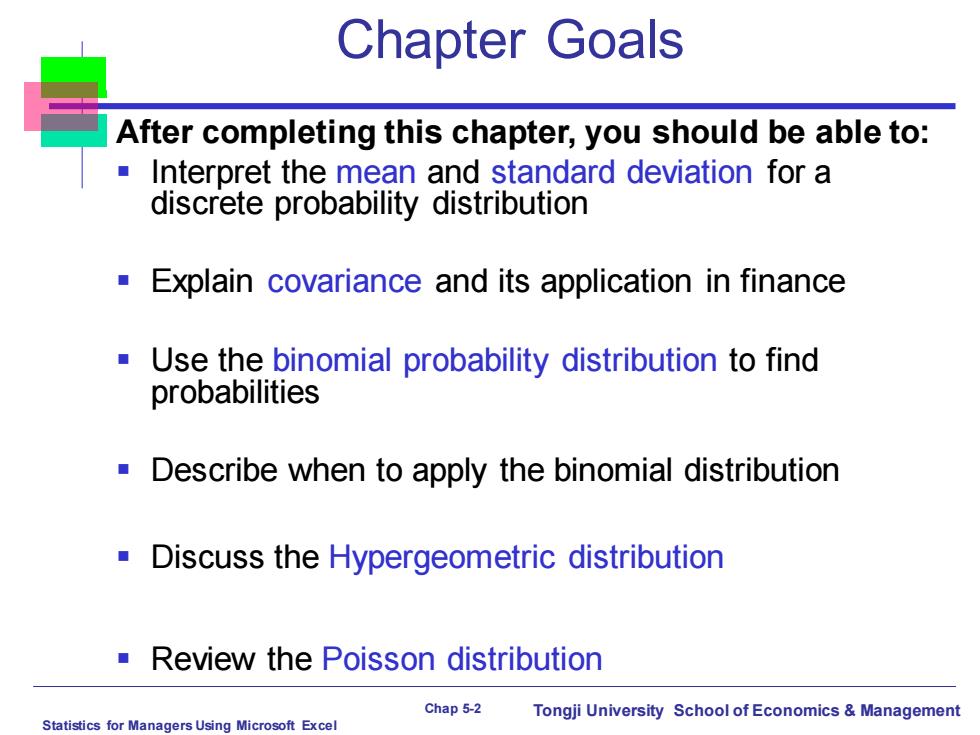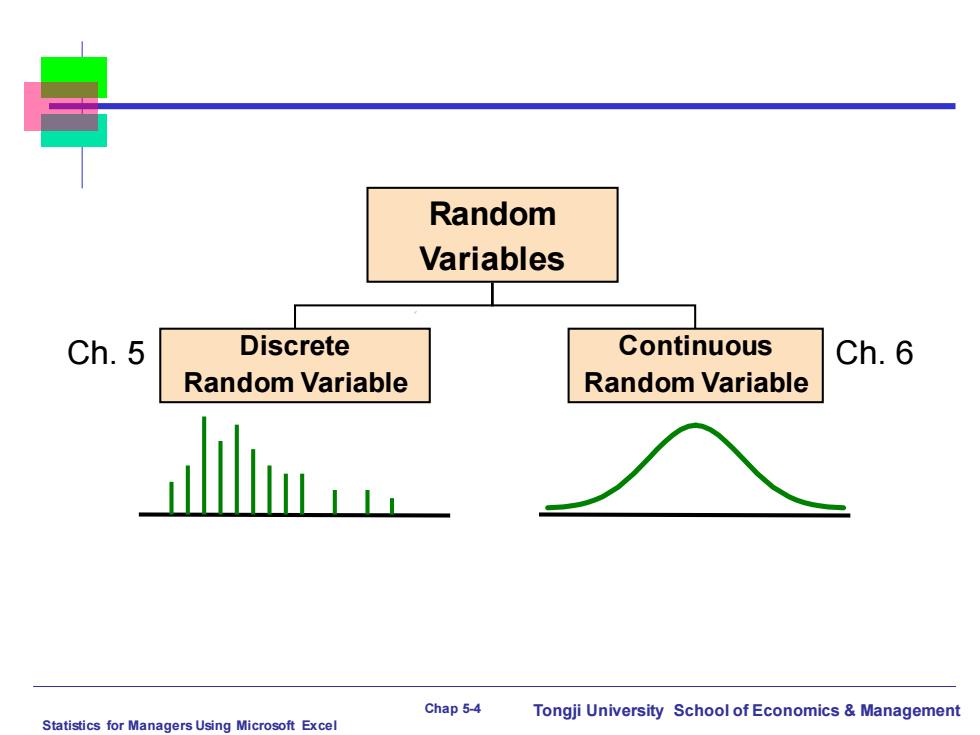
Statistics for Managers Using Microsoft Excel Chapter 5 Some Important Discrete Probability Distributions Statistics for Managers Using Microsoft Excel Chap 5-1
Statistics for Managers Using Microsoft Excel Chap 5-1 Chapter 5 Some Important Discrete Probability Distributions Statistics for Managers Using Microsoft® Excel

Chapter Goals After completing this chapter,you should be able to: Interpret the mean and standard deviation for a discrete probability distribution ■ Explain covariance and its application in finance Use the binomial probability distribution to find probabilities Describe when to apply the binomial distribution Discuss the Hypergeometric distribution Review the Poisson distribution Chap 5-2 Tongji University School of Economics&Management Statistics for Managers Using Microsoft Excel
Statistics for Managers Using Microsoft Excel Chap 5-2 Tongji University School of Economics & Management Chapter Goals After completing this chapter, you should be able to: ▪ Interpret the mean and standard deviation for a discrete probability distribution ▪ Explain covariance and its application in finance ▪ Use the binomial probability distribution to find probabilities ▪ Describe when to apply the binomial distribution ▪ Discuss the Hypergeometric distribution ▪ Review the Poisson distribution

Introduction to Probability Distributions Random Variable Represents a possible numerical value from an uncertain event Discrete random variables produce outcomes that come from a counting process (e.g. number of classes you are taking). Continuous random variables produce outcomes that come from a measurement (e.g. your annual salary,or your weight). Chap 5-3 Tongji University School of Economics Management Statistics for Managers Using Microsoft Excel
Statistics for Managers Using Microsoft Excel Chap 5-3 Tongji University School of Economics & Management Introduction to Probability Distributions ▪ Random Variable ▪ Represents a possible numerical value from an uncertain event ▪ Discrete random variables produce outcomes that come from a counting process (e.g. number of classes you are taking). ▪ Continuous random variables produce outcomes that come from a measurement (e.g. your annual salary, or your weight)

Random Variables Ch.5 Discrete Continuous Ch.6 Random Variable Random Variable Chap 5-4 Tongji University School of Economics Management Statistics for Managers Using Microsoft Excel
Statistics for Managers Using Microsoft Excel Chap 5-4 Tongji University School of Economics & Management Random Variables Discrete Random Variable Continuous Random Variable Ch. 5 Ch. 6

Discrete Random Variables Can only assume a countable number of values Examples: ■Roll a die twice Let X be the number of times 4 comes up (then X could be 0,1,or 2 times) Toss a coin 5 times. Let X be the number of heads (then X=0,1,2,3,4,or5) Chap 5-5 Tongji University School of Economics Management Statistics for Managers Using Microsoft Excel
Statistics for Managers Using Microsoft Excel Chap 5-5 Tongji University School of Economics & Management Discrete Random Variables ▪ Can only assume a countable number of values Examples: ▪ Roll a die twice Let X be the number of times 4 comes up (then X could be 0, 1, or 2 times) ▪ Toss a coin 5 times. Let X be the number of heads (then X = 0, 1, 2, 3, 4, or 5)

Discrete Probability Distribution Experiment:Toss 2 Coins.Let X =heads. 4 possible outcomes Probability Distribution X Value Probability 0 114=.25 2/4=.50 2 114=.25 50 2 0 1 2 X Chap 5-6 Tongji University School of Economics Management Statistics for Managers Using Microsoft Excel
Statistics for Managers Using Microsoft Excel Chap 5-6 Tongji University School of Economics & Management Probability Distribution 0 1 2 X X Value Probability 0 1/4 = .25 1 2/4 = .50 2 1/4 = .25 .50 .25 Probability Experiment: Toss 2 Coins. Let X = # heads. T T Discrete Probability Distribution 4 possible outcomes T T H H H H

Practices in Class -Practice:Let the random variable X represents the number of boys in a family,construct the probability distribution for a family of three children 89 P(X)) 0 1/8 1 3/8 13 2 3/8 3 1/8 Chap 5-7 Tongji University School of Economics Management Statistics for Managers Using Microsoft Excel
Statistics for Managers Using Microsoft Excel Chap 5-7 Tongji University School of Economics & Management Practices in Class ▪ Practice: Let the random variable X represents the number of boys in a family, construct the probability distribution for a family of three children X P(X) 0 1/8 1 3/8 2 3/8 3 1/8

Discrete Random Variable Summary Measures Expected Value of a discrete distribution (Weighted Average) N H=EX)=∑XP(X) X P(X) Example:Toss 2 coins, 0 .25 X=#of heads, .50 compute expected value of X: .25 E(X)=(0x.25)+(1×.50)+(2x.25) =1.0 Chap 5-8 Tongji University School of Economics Management Statistics for Managers Using Microsoft Excel
Statistics for Managers Using Microsoft Excel Chap 5-8 Tongji University School of Economics & Management Discrete Random Variable Summary Measures ▪ Expected Value of a discrete distribution (Weighted Average) ▪ Example: Toss 2 coins, X = # of heads, compute expected value of X: E(X) = (0 x .25) + (1 x .50) + (2 x .25) = 1.0 X P(X) 0 .25 1 .50 2 .25 = = = N i 1 i i E(X) X P(X )

Discrete Random Variable Summary Measures (continued) Variance of a discrete random variable W o2=∑X,-EX)PPX,) i=1 Standard Deviation of a discrete random variable N =V2=∑X-EXPX) where: E(X)=Expected value of the discrete random variable X Xi the ith outcome of X P(Xi)=Probability of the ith occurrence of X Chap 5-9 Statistics for Managers Using Microsoft Excel Tongji University School of Economics Management
Statistics for Managers Using Microsoft Excel Chap 5-9 Tongji University School of Economics & Management ▪ Variance of a discrete random variable ▪ Standard Deviation of a discrete random variable where: E(X) = Expected value of the discrete random variable X Xi = the ith outcome of X P(Xi ) = Probability of the ith occurrence of X Discrete Random Variable Summary Measures = = − N i 1 i 2 i 2 σ [X E(X)] P(X ) (continued) = = = − N i 1 i 2 i 2 σ σ [X E(X)] P(X )

Discrete Random Variable Summary Measures (continued) Example:Toss 2 coins,X =heads, compute standard deviation (recall E(X)=1) V∑X-E(X]P(X) 0=V0-1)2(.25)+(1-1)2(.50)+(2-1)2(.25)=V.50=.707 X P(X) 0 .25 Possible number of heads 1 .50 =0,1,0r2 2 25 Chap 5-10 Tongji University School of Economics Management Statistics for Managers Using Microsoft Excel
Statistics for Managers Using Microsoft Excel Chap 5-10 Tongji University School of Economics & Management ▪ Example: Toss 2 coins, X = # heads, compute standard deviation (recall E(X) = 1) Discrete Random Variable Summary Measures σ [X E(X)] P(X )i 2 i = − σ (0 1) (.25) (1 1) (.50) (2 1) (.25) .50 .707 2 2 2 = − + − + − = = (continued) X P(X) 0 .25 1 .50 2 .25 Possible number of heads = 0, 1, or 2